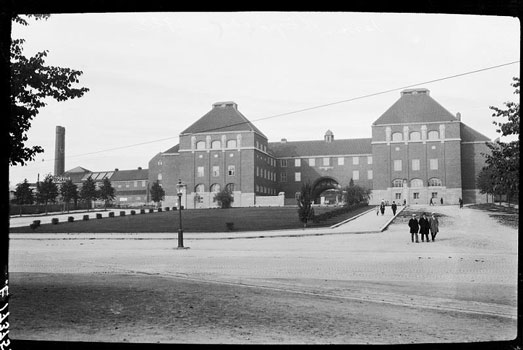1. A technological institute 1827 becomes KTH Valhallvägen in 1920
The need of technically knowledgeable persons for the growing industrial sector was the reason that in 1827 the Technological Institute started its activity in central Stockholm, following a 1825 government order. The first lecture, in mathematics, was given on June 6, 1827. According to the byelaws the teaching should be “..more popular and practical than scientific”. There were no admission requirements. The first director was Gustaf Magnus Schwartz (1783-1858), professor in physics at the Royal Academy of Sciences. In the re-organization of 1846 the institute was given a focus more comparable to an engineering education. Schwartz stepped down and an admission test was introduced. The institute had at the time three professors, but none in physics.

The activity of the institute was growing following industrialization trends and in the byelaws of 1858 a chair in physics was established. However, the institute was very cramped. Between 1800-1863 government grant made it possible to build a new main building at Drottninggatan 95. The 1867 byelaws for the first time stated that the teaching should give scientific education. At the same time new admission requirements were introduced.
On the 50th anniversary, 1877, the government changed the name of the institute to the Royal Institute of Technology. In the new byelaws of that year KTH was organized into professional schools. The admission requirements were abolished for high school students in science. Gustaf Robert Dahlander (1834-1903), professor in physics from 1870, became KTH President 1890-1902. His chair in physics was converted to a chair in electrical engineering in 1901. Dahlander introduced a high school exam as admission requirement and established several new professional schools, e.g. one in electrical engineering. There was no chair in physics until 1911 when Pehr av Bjerken (1859-1919), who was a lecturer in physics at the institute from 1899, was appointed professor in physics. At the turn of the century there were five physics chairs in Sweden, at the Chalmers, KTH, Lund and Uppsla university and Stockholm university college.

A parliamentary decision in 1911 laid the groundwork for a substantial enlargement of KTH. New buildings should be constructed at the northern part of Djurgården. KTH should be reorganized. Lectureships were phased out and in 1913 there were 24 professors and a number of extra teachers. New chairs were added and in 1925/26 there were 34 professors and 130 other teachers. New buildings at Valhallavägen were inaugurated 1917. However, it took long a time to completely move out of the Drottninggatan 95 building. Physics moved in 1930 and land surveying stayed until 1958! KTH was, in 1927, given the right to award the degree of doctor.


